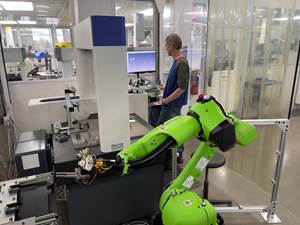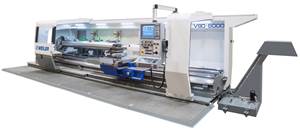Supply-Side Robotics
It’s not just the promise of automation that drives robot adoption, but also the cost of the technology. Will price declines bring about much more widespread use of robots in manufacturing?
According to the Robotic Industries Association (RIA), robots in North America just had their strongest year ever. A total of 27,685 robots with a combined value of $1.6 billion were ordered from North American companies during 2014. In terms of both units and dollars, that was a major increase over 2013.
But the units increased more than the dollars. According to RIA, the number of robots ordered was up 28 percent from the previous year, while the value of those robots was up 19 percent. Were companies buying a different mix of robots in 2014 compared to what was purchased the preceding year? That is, did companies buy a greater share of lower-end models in 2014? If the answer is no—if the product mix was basically the same from one year to the next—then these figures say that the unit cost of robots must have declined in one year by 7 percent.
That possibility highlights something significant about the use of robots and the factor that might bring about a dramatic increase in the application of robots for manufacturing. When we think about robots in manufacturing, we tend to focus on the transformative effect of robotic automation, plus the general level of fascination most of us have with this technology. Robots can liberate people from mundane tasks, and robots have always been part of the future we anticipate. However, these are demand-side views of robots. They emphasize the case for, or the enthusiasm for, robotic automation. There is also a supply-side view, emphasizing robot cost—and this perspective might ultimately be more revealing. If the price of robots is coming down, then more and more manufacturing applications are liable to cross the threshold beyond which installing a robot makes clear financial sense.
The Boston Consulting Group thinks it has identified this threshold. A study from this group suggests that manufacturers tend to make robotics investments whenever the total cost of the automation represents a 15-percent savings over paying a human being to do the same task.
That figure is for manufacturing in general. In the specific area of CNC machining, the same principle applies, but I think the story is different. Machining facilities adopting robots frequently make the promise that no current staff will lose their jobs as a result of the automation. The promise is easy to keep, because the employees in a machining facility (even the less experienced or less credentialed ones) generally have skills or training that make them valuable without regard to the automation. The challenge in machining is to find more people who have or can acquire these skills. Investing in robots is therefore seen as a way to expand capacity by multiplying the efforts of the current staff, rather than devoting resources to trying to find and develop many more such staff members. So: Even though there is a different calculation in a machine shop, there is still a calculation related to labor, meaning the robot stands to win adoption as the price of robots goes down.
Over the long term, it seems that the price of robots certainly has been going down. The Boston report cites the example of the total cost of owning and operating a spot-welding robot, which has declined from $182,000 in 2005 to $133,000 now and is forecast to drop another 22 percent by 2025. Meanwhile, the very options in robots are changing, with collaborative robots capable of lightweight, human-speed automation now available for a fraction of the typical industrial robot’s price.
On top of all of this, it’s worth at least pointing out the two major players that might bring the cost of robotics down even further. One is Google. The company has acquired several robotics firms and set up a new robotics group that is working to, among other things, create a new robot operating system for manufacturers. The other wild card is China, which has seen a surge in robot manufacturing (feeding the supply side of the robot equation) in response to government stimulation of robot production.
How will manufacturing change if declining robot pricing reaches a tipping point that results in even greater use of robotics? Part of the answer is that the very look and nature of the typical manufacturing facility might change. The same might be true of the typical machining facility. And I think that change could draw employees. The teenager of today who doesn’t connect with an appreciation for making a part on a machine tool might nevertheless be impelled to pursue a vocation in manufacturing by the possibility of programming and overseeing a battery of robots. Thinking of the teenagers I know (I’m the parent of one), I could readily see how that particular possibility might inspire them. Ironically, the move to robotic automation might have a role in addressing the problem of attracting talent.
Related Content
4 Steps to a Cobot Culture: How Thyssenkrupp Bilstein Has Answered Staffing Shortages With Economical Automation
Safe, economical automation using collaborative robots can transform a manufacturing facility and overcome staffing shortfalls, but it takes additional investment and a systemized approach to automation in order to realize this change.
Read MoreBeyond the Machines: How Quality Control Software Is Automating Measurement & Inspection
A high-precision shop producing medical and aerospace parts was about to lose its quality management system. When it found a replacement, it also found a partner that helped the shop bring a new level of automation to its inspection process.
Read MoreModern Bar Feeds Bring New Life to Automatic Swiss Lathes
Cam-actuated Swiss lathes are still the fastest way to process many parts. By adding modern bar feeders, this shop has dramatically improved their utilization with the ability to work unattended, even in a lights-out environment.
Read MoreWeiler to Debut New Automation Features For Its Lathes
Weiler’s V 110 four-way precision lathe introduces features new to the U.S.
Read MoreRead Next
The Cut Scene: The Finer Details of Large-Format Machining
Small details and features can have an outsized impact on large parts, such as Barbco’s collapsible utility drill head.
Read More3 Mistakes That Cause CNC Programs to Fail
Despite enhancements to manufacturing technology, there are still issues today that can cause programs to fail. These failures can cause lost time, scrapped parts, damaged machines and even injured operators.
Read More
.jpg;width=70;height=70;mode=crop)














.png;maxWidth=300;quality=90)
.png;maxWidth=300;quality=90)









